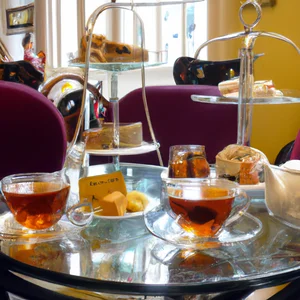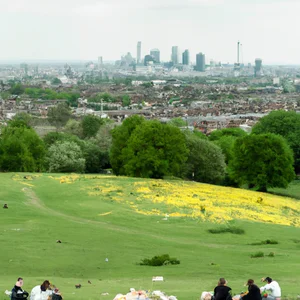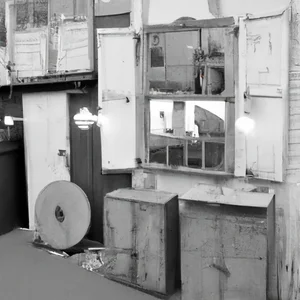Book your experience
St Pancras Renaissance Hotel: Rebirth of a neo-Gothic masterpiece
St Pancras Renaissance Hotel: The rebirth of a neo-Gothic jewel
So, let’s talk about the St Pancras Renaissance Hotel, which is truly a dream place, like a castle that has been brought back to life. When I went there for the first time, I couldn’t believe it: that neo-Gothic building is a true marvel, with those red bricks that almost seem to tell ancient stories.
You know, it’s as if you’ve crossed the threshold of a period film, with all those details that leave you speechless. The towers soaring into the sky, the stained glass windows… I mean, it looks like a place where you might meet Sherlock Holmes, doesn’t it? And then, the lobby is so spacious and welcoming that you immediately feel at home, even if you are actually in a luxury hotel.
And here comes the best part: this place is not only a beautiful sight, but also has a crazy history. It was built in 1868, so talk about a piece of history! He saw a lot of people pass by, travellers, adventurers and so on and so forth. I think it’s fascinating to think of all the stories those walls could tell, if only they could talk.
Maybe not everyone knows it, but after a long period of abandonment, this hotel reopened in 2011, and the renovation was truly impressive. It’s as if they gave a second life to an old friend. The combination of vintage charm and modern comforts is simply brilliant.
Well, if I had to give advice to someone who is thinking of staying there, I would say not to miss the opportunity to take a tour around the area. The area is full of life, there are amazing restaurants and, believe me, King’s Cross Market is a place where you can find everything from fusion food to art.
In short, the St Pancras Renaissance Hotel is not just a hotel, it is an experience, a sort of journey through time. I don’t know, maybe it’s because I’ve always had a passion for architecture and ancient stories, but every time I go back, I seem to discover something new. If you have the opportunity, don’t miss it!
St Pancras Renaissance Hotel: Rebirth of a neo-Gothic masterpiece
Fascinating history: the connection with the past
Imagine crossing the threshold of a place that seems to pulsate with stories, a place where the past is intertwined with the present. The St Pancras Renaissance Hotel is not just a hotel; it is a monument that tells a fascinating narrative of rebirth and transformation. I remember the moment I entered the main entrance, under the majestic arches, and felt like a 19th century traveler, ready to embark on an adventure through time.
Originally built in 1873 as a train station, the Gothic Revival-style building was designed by architect George Gilbert Scott. In the 1980s, after a long period of abandonment and decay, the structure was saved from demolition thanks to an ambitious restoration project that returned one of its architectural jewels to the city. Today, the St Pancras Renaissance Hotel not only hosts travellers, but is also a symbol of London’s resilience and architectural beauty.
If you want to delve deeper into the history of this masterpiece, I recommend visiting the British Library nearby, where you can find historical documents and photographs that tell the story of the life of the hotel and the station over the years.
A golden tip
A little-known secret is that, if you are staying at the hotel, you can ask to visit the famous Smoking Room, a historic room that was once reserved for upper-class travellers. This hidden corner offers an intimate atmosphere and an unrivaled view of the station’s neo-Gothic architecture.
The cultural impact
St Pancras has had a significant impact not only on London’s architecture, but also on travel culture. With the opening of the Eurostar in 2007, the building regained its original function as a transport hub, connecting London with Europe and bringing back the concept of travel as an experience of discovery.
Sustainability and responsibility
In the modern era, the St Pancras Renaissance Hotel has embraced sustainable practices, such as using local produce in its restaurants and implementing technologies that reduce energy consumption. By choosing to stay here, you will not only have a historical experience, but you will also contribute to more responsible tourism.
An experience not to be missed
As you explore the hotel, take a moment to admire the lobby’s glass ceiling, a masterpiece that reflects light in extraordinary ways. And if you have time, take a guided tour to discover architectural and historical details that escape the untrained eye.
Myths and misconceptions
A common misconception is that the St Pancras Renaissance Hotel is only accessible to those who can afford a night of luxury. In fact, the hotel offers several stay options and even guided tours, making history accessible to everyone, regardless of budget.
Final reflection
As you leave the St Pancras Renaissance Hotel, I invite you to reflect on how history and architecture can influence our travel experiences. What story will you take away from this neo-Gothic masterpiece?
Neo-Gothic architecture: details not to be missed
A close encounter with history
Walking through the streets of a city rich in history, I found myself in front of an imposing neo-Gothic cathedral, whose spiers stood out against the blue sky. It was a sunny afternoon and the light filtered through the stained glass windows, creating an almost magical atmosphere. At that moment, I understood that neo-Gothic architecture is not just a collection of styles and forms; it is a journey through time that tells stories of past eras. With every step, the whisper of stone spoke to me of artists and craftsmen who, centuries ago, dedicated their lives to creating a lasting legacy.
Details to admire
Neo-Gothic architecture, characterized by pointed arches, soaring spiers and elaborate decorations, is a triumph of creativity and symbolism. Don’t miss the opportunity to admire the following details:
- Stained Glass: These masterpieces tell biblical stories and local legends, reflecting light in breathtaking ways.
- Ornamental sculptures: Each figure, from saints to fantastic monsters, has a story to tell and a profound meaning, often linked to the culture of the area.
- Spires and pinnacles: These structures not only add height and grace, but also served to symbolize the connection between heaven and earth.
An insider tip
A little-known secret is that many neo-Gothic buildings house hidden gardens or internal courtyards, where visitors can enjoy a unique and tranquil perspective. These places, often overlooked, are perfect for a meditative break away from the tourist bustle.
Cultural and historical impact
Gothic Revival architecture emerged in the 19th century as a way to evoke the grandeur of the medieval past, responding to a desire for cultural identity in a time of rapid change. This current influenced not only religious architecture, but also public and private buildings, becoming a symbol of local pride and artistic innovation.
Sustainability and responsibility
Today, many neo-Gothic building restoration projects focus on sustainable practices, using local materials and traditional techniques to preserve these architectural treasures. Choose to visit these structures responsibly, respecting the environment and the history they represent.
An experience worth trying
I recommend you take part in a nocturnal guided tour of a neo-Gothic cathedral, where artificial lights enhance the beauty of the architecture and the guide tells stories fascinating. This will allow you to live an immersive experience and discover details that often escape daytime visitors.
Myths and misconceptions
A common myth is that Gothic Revival architecture is just an imitation of the past. In reality, it is a reinterpretation that was able to blend traditional elements with technical innovations of the time, creating a unique and original architectural language.
A final reflection
As you walk among the spiers and sculptures, ask yourself: How have these works of art influenced the local community and culture over the centuries? Be immersed in the beauty of an era and consider the importance of preserving these places for future generations. History is alive and palpable in every stone; don’t miss the opportunity to discover it.
A dream living room: rooms to explore
When I crossed the threshold of my room at the hotel, a smile spread across my face. The walls were decorated with pastel tones and vintage furnishings, creating an atmosphere that seemed to tell stories of bygone eras. The view from the window, which overlooked a lush garden, immediately transported me to a world of tranquility. Every corner of the room seemed to have been designed to provide a stay experience that was not only comfortable, but also memorable.
Dream rooms: an enchanting design
The hotel’s rooms offer a range of options, from elegant suites equipped with whirlpool tubs to romantic penthouses with terraces. Each room is a work of art in its own right, filled with neo-Gothic architectural details that blend harmoniously with modern comforts. According to the hotel’s official website, the rooms were recently renovated using local materials to ensure an eco-friendly and sustainable footprint.
An insider tip
A little-known option is the ability to book a “thematic room”, which reflects a chapter in local history. These rooms offer not only a living room, but also an immersive experience, with books, artwork and decorations that tell forgotten stories. This is not just a way to sleep, but an invitation to explore the culture of the place.
Cultural impact and historicity
Choosing to stay at this hotel is not just a question of luxury, but a way to connect with the historical roots of the destination. Each room is a testimony to the architectural and social evolution of the area, a tangible link with the past that enriches every stay. The hotel has also partnered with local historians to offer visitors guided tours that explore the history of the palace and its architecture.
Sustainability: a responsible stay
The hotel is committed to sustainability, using renewable energy and recycling practices to reduce environmental impact. Guests are encouraged to participate in local cleanup and reforestation initiatives. Furthermore, the rooms are equipped with eco-friendly personal care products, to ensure that every stay is not only pleasant, but also environmentally friendly.
An unmissable activity
Don’t miss the opportunity to book a “history and relaxation” experience, which includes a night in one of the themed rooms followed by a private tour of the palace, where you can discover fascinating anecdotes and curiosities about the hotel’s past.
Myths and misconceptions
A common misconception is that luxury rooms are always unaffordable. In fact, many of the themed rooms offer competitive rates, especially during low season periods. It is always advisable to check the special offers on the hotel website to discover advantageous rates.
In conclusion, choosing to stay at this hotel is much more than just a night away from home. It invites us to reflect on how our environment affects our travel experiences. What story would you like to discover during your next stay?
Culinary experiences: local flavors at the restaurant
A journey into flavors
When I first set foot in the local restaurant of a charming village, I never imagined that my palate was about to embark on such an unforgettable journey. Sitting at an outdoor table, surrounded by stone walls and colorful flowers, I ordered a typical dish, perch risotto. The freshness of the ingredients and the mastery of the chef transported me to a dimension of authentic flavors rooted in the culinary tradition of the region.
Local flavors not to be missed
Recently, the restaurant introduced a seasonal menu that celebrates local produce, such as wild asparagus and porcini mushrooms, which can be found in local markets. Each dish tells a story, and the passionate and knowledgeable staff is ready to guide you in choosing the perfect wine to match. Don’t forget to also taste the house tiramisu, prepared according to a recipe handed down for generations.
An insider’s tip
A little-known tip is to visit the restaurant during the Saturday morning farmers market. Here, you will have the opportunity to taste dishes prepared directly by local farmers, often at very advantageous prices. This is not only a way to enjoy fresh food, but also a way to immerse yourself in the local culture and interact with the community.
The cultural impact of cuisine
The cuisine of this region is not just food; it’s a way of life. Each dish is a reflection of its history, traditions and cultural identity. Menus are designed to honor native ingredients, a clear example of how gastronomy can serve as a bridge between past and present.
Sustainability at the table
Many restaurants are embracing sustainable tourism practices, such as using organic ingredients and supporting local farmers. This not only reduces the environmental impact, but also guarantees the freshness and quality of the dishes served. Choosing a restaurant that adopts these principles is a way to contribute to a form of responsible tourism.
An experience worth trying
Absolutely not to be missed is the cooking masterclass held in the restaurant. Here, you will have the opportunity to learn the secrets of local cuisine directly from expert chefs. It is an experience that not only enriches your cultural background, but allows you to bring home a piece of this culinary tradition.
Myths and misconceptions
A common misconception is that local cuisine is expensive or unaffordable. In fact, there are many options for every budget, and street food is another unmissable experience. Savoring a simple focaccia or homemade ice cream can be just as delicious as a gourmet meal.
A new perspective
As I reflected on that unexpected culinary discovery, I asked myself: how much can the food we taste influence our perception of a place? With every bite, we not only nourish the body, but also the soul and our connection with culture that surrounds us. Are you ready to discover flavors that tell stories?
Sustainability on the go: responsible choices here
A personal sustainable travel experience
I still remember my stay in a small ecological structure surrounded by nature, where every morning I woke up to the birds singing and the scent of organic coffee. The owner, passionate about sustainability, told me how she had converted her dream of hosting tourists into a real eco-friendly refuge, respecting the environment and the local community. This meeting made me reflect on how important it is, today more than ever, to choose responsible travellers.
Practical and up-to-date information
When talking about sustainability in tourism, it is essential to consider facilities that adopt eco-friendly practices. For example, many hotels now use renewable energy, offer organic personal care products and promote recycling. In [Destination Name], one of the most renowned properties is the EcoGreen Hotel, which has obtained the Green Key certification for its efforts to reduce environmental impact. This hotel not only provides a comfortable stay, but also encourages visitors to explore the area responsibly, implementing practices such as recycling and using bicycles to get around.
An insider tip
A little-known tip for tourists is to attend a local cooking workshop organized by local producers. Not only will you have the opportunity to learn traditional recipes, but also to discover 0 km ingredients, thus supporting the local economy and reducing the carbon footprint associated with food transport. These experiences not only enrich your stay, but also create authentic connections with the community.
The cultural impact of sustainability
Adopting sustainable practices is not just a fad, but a way to preserve the cultural and natural heritage of the destination. Investing in responsible tourism also means protecting the places we visit, ensuring that future generations can enjoy the same beauty and authenticity that we have been lucky enough to experience. Local culture, artisan traditions and gastronomic experiences are all enriched by the choice of sustainable practices.
Responsible tourism practices
Today many accommodation facilities are embracing the concept of responsible tourism. Opting for a hotel that uses eco-friendly products and supports local initiatives not only improves your experience, but also contributes to a more sustainable future for everyone. Furthermore, many of these hotels collaborate with local associations to organize events that raise visitors’ awareness of the importance of sustainability.
Immerse yourself in the atmosphere
Imagine walking through the cobbled streets of an ancient village, surrounded by historic buildings and centuries-old trees, while the scent of aromatic herbs and local dishes invites you to stop. Every corner tells a story, and by choosing to support sustainable practices, you help keep that story alive. The beauty of nature and local culture is a precious resource, and it is up to us to protect it.
An activity worth trying
An absolute must is a guided excursion to a natural park, where you can explore the local flora and fauna. Many tour operators offer hiking or cycling tours, educating participants on how to preserve the environment and support local communities. There is no better way to appreciate the natural beauty of a place than through an active and conscious experience.
Myths to dispel
A common misconception is that sustainable tourism means giving up comfort or luxury. In fact, many eco-friendly properties offer high-quality services, proving that it is possible to travel responsibly without compromising the pleasure of your stay. Choosing a sustainable hotel does not mean sacrificing luxury, but rather making a conscious choice that enriches your travel experience.
A personal reflection
When we travel, what choices do we really make to protect the places we love? The next time you plan an escape, we encourage you to consider how your decisions may affect the local environment and culture. How might you integrate sustainable practices into your travel? Be inspired by a way of traveling that not only enriches yourself, but also the world around you.
Extraordinary events: what not to miss at the hotel
An experience that leaves its mark
During my visit to a magnificent neo-Gothic hotel nestled in the countryside, I was greeted by an event that transformed my perception of hospitality. The evening was dedicated to a classical music concert, hosted in the hotel’s historic ballroom. The sounds of harps and violins mixed with the echoes of past stories that those walls had heard. It was a magical moment, a memory that brings with it the essence of that enchanting place.
Events that enrich your stay
Historic hotels are not just places to stay overnight; they are real cultural centers that offer a variety of extraordinary events. Whether concerts, art exhibitions, or local wine tasting evenings, each activity is designed to immerse guests in the culture and history of the location. According to the hotel’s official website, events are planned well in advance and are often held in collaboration with local artists and producers, making each experience unique and authentic.
An insider tip
If you want a memorable experience, ask hotel staff if there are any private or exclusive events guests can attend. Many times, there are tasting evenings of dishes prepared by renowned chefs, which are not advertised but are only open to a lucky few. This is an excellent way to explore local gastronomy and meet other people with similar interests.
The cultural impact of events
Events organized within the hotel not only enrich the guest experience, but also help preserve and promote local culture. Every concert, every art exhibition, is an opportunity to enhance local talents and raise awareness of local traditions. This approach not only supports the community, but creates a deep bond between guests and the area.
Sustainability and responsibility
Many hotels are integrating sustainability practices into their events. This can include the use of 0 km food products, the invitation of local artists to reduce the environmental impact of transport, or the organization of events that raise guests’ awareness of issues of social and environmental relevance. Participating in these events is not only a way to have fun, but also to support responsible tourism.
A dream atmosphere
Imagine sipping a glass of local wine while listening to the sweet melodies of a string quartet, surrounded by historic frescoes and glittering chandeliers. The atmosphere is full of emotion and history, making every moment unforgettable. Events at the hotel are more than just entertainment; they are experiences that enrich the stay and leave a mark in the hearts of those who participate.
An activity not to be missed
If you have the opportunity to be present during a special event, don’t miss the chance to interact with the artists. Many of them are happy to share their stories and passions, creating a bond that goes beyond simple performance. You may even discover emerging talent that you would never have known otherwise.
Myths and misconceptions
A common myth is that events at historic hotels are reserved only for high-profile or expensive guests. In fact, many of these events are accessible to all and can be a great way to experience the place at a reasonable price. Always inquire at reception about what is available during your stay.
A final reflection
Attending an extraordinary event in a historic hotel is more than just entertainment; it’s a way to connect with the culture and history of a place. What event would you like to experience on your next trip? Let curiosity guide you in discovering these unique experiences.
Discover the secret garden
A dream experience
On my latest visit to this fascinating destination, I came across a place that felt like something out of the way from a dream: a secret garden, hidden behind the high walls of an old palace. The entrance was discreet, almost invisible, but once I crossed the wrought iron gate, I found myself in a corner of paradise. Colorful flowers danced to the rhythm of the wind, while the scent of lavender permeated the air. It was a moment of pure serenity, away from the hustle and bustle of everyday life.
Practical information
This garden is open to the public only at certain times, and it is advisable to book in advance to access it. Local guides, like those at Visit Lazio, offer tours that include this hidden corner, revealing not only the natural beauty, but also fascinating stories linked to the nobles who once inhabited the area.
An insider tip
If you really want to immerse yourself in the enchanting atmosphere of the garden, visit during the early hours of the morning. The sunlight filtering through the leaves creates a magical atmosphere, and the quiet of the morning will allow you to appreciate every detail without the crowds of tourists.
Cultural impact
This garden is not only a place of beauty, but represents an important part of the cultural heritage of the area. It symbolizes the link between nature and the art of living, a concept that dates back to the times of Renaissance gardens. It is an example of how beauty can be preserved and enhanced over time.
Sustainability and responsibility
Many of the historic gardens are embracing sustainable practices. In this case, the garden is maintained using organic gardening techniques, reducing the use of chemical pesticides and promoting local biodiversity. By visiting the garden, you not only enjoy the beauty, but also support an ecological initiative.
Immersive atmosphere
Imagine walking along the meandering paths, surrounded by ancient trees and flower beds. Birdsong accompanies your steps, while small fountains gush softly. Every corner of the garden contains a secret, an invitation to discover the beauty of what surrounds us.
An unmissable activity
Don’t miss the opportunity to participate in an organic gardening workshop, where you can learn sustainable growing techniques directly from local gardeners. It’s a unique way to connect with the community and bring a piece of this experience home.
Myths to dispel
A common misconception is that historic gardens are reserved only for the extreme elite. In reality, these spaces are open to all and represent a shared cultural heritage to explore and appreciate.
Final reflection
This secret garden made me reflect on the importance of finding moments of tranquility and beauty in our busy lives. Have you ever stopped to consider how regenerating a simple corner of nature can be? Who knows, you might discover your own secret garden.
Culture and art: works of art to admire
Walking through the corridors of the St Pancras Renaissance Hotel, it is impossible not to be struck by the rich cultural atmosphere that permeates every corner. I vividly remember the moment I walked through the door of the hotel, and the sight of the artwork adorning the foyer left me speechless. Each piece seems to tell a story, a fragment of a past that continues to live in the present.
A journey through art
The St Pancras Renaissance is not just a place to spend the night, but a real open-air museum. The works of art on display, which range from modern sculptures to historical paintings, offer a snapshot of British artistic creativity. Don’t forget to admire the majestic fresco depicting the history of the railway, a tribute to the crucial role this hotel played in the development of transport in Great Britain.
In particular, you can’t miss the delicate stained glass windows that decorate the common areas, works of art that reflect the craftsmanship of the Victorian era. Every detail has been cared for with passion, and these windows tell stories of travelers and adventures that have shaped modern London.
An insider tip
If you want to discover a lesser-known work of art, pay a visit to the hotel lounge, where you will find a small gallery of historic photographs documenting the evolution of St Pancras and its community. This hidden corner is often overlooked by tourists, but it represents a unique opportunity to immerse yourself in memories of a bygone era. Here, you can admire images of famous people and highlights of London’s history, making your visit even more meaningful.
A lasting cultural impact
The cultural impact of this hotel goes far beyond its walls. St Pancras has become a symbol of rebirth for London, a place where art and architecture intertwine to tell a larger narrative. Its renovation not only preserved the historic beauty, but also created a new space that celebrates contemporary creativity. The combination of history and innovation has made this place a dynamic center for artistic and cultural events.
Responsible tourism practices
In an age where sustainable tourism is of paramount importance, St Pancras Renaissance Hotel is committed to promoting responsible practices. The hotel collaborates with local artists to exhibit their work, providing a platform for emerging talent and contributing to the wellbeing of London’s artistic community. Staying here means not only enjoying a unique experience, but also supporting initiatives that make a difference.
An experience not to be missed
For those who want to fully immerse themselves in the culture and art of London, I highly recommend booking a guided tour of the hotel. During your visit, you will have the opportunity to learn more about the artworks and their artists, as well as the fascinating history of St Pancras. This experience will enrich your understanding of the place and leave you with a lasting memory.
A new perspective
Many may think that a hotel is just a place to sleep, but the St Pancras Renaissance Hotel proves that a building can be much more. Reflections on art and culture intertwine in this space, inviting each visitor to explore their own connection with history and creativity. We invite you to consider: How can a place transform your perception of history and art?
Encounters with history: famous visitors
I clearly remember the moment I walked through the doors of the St Pancras Renaissance Hotel; the feeling of being part of a bigger story enveloped me like a warm blanket. Imagine walking on the floors that have welcomed the footsteps of historical figures and celebrities over the decades. The lobby, with its vaulted ceilings and delicate scent of history, seems to whisper tales of those who have stayed here before us.
A hotel that has seen the world
Over the years, the St Pancras Renaissance Hotel has hosted a myriad of celebrities and illustrious figures, from writers and musicians to nobles and politicians. If walls could talk, they would tell of meetings between people who changed the world. Among the best-known visitors have been names such as Charles Dickens and Agatha Christie, who found inspiration in the hotel’s elegant rooms and vibrant atmosphere. This connection to history is not only fascinating, but also invites the traveler to reflect on how the past continues to influence the present.
An insider tip
If you want an authentic experience, look into booking one of the historic suites overlooking St Pancras station. Not only will you have a breathtaking view, but you can also imagine the frenzy of travellers who, like you, have dreamed of adventures beyond the sea. And if you have time, go down to the hotel bar for a drink: there you might even meet some contemporary artists or writers, attracted by the irresistible charm of this place.
The historical and cultural impact
The history of the St Pancras Renaissance Hotel is a reflection of the change in London itself. Built in 1868, the hotel was not only a symbol of the architectural progress of the Victorian era, but also a testament to the central role London played in connecting cultures and people. Today, the hotel is a point of reference for sustainable tourism, committed to preserving not only its architectural beauty, but also the cultural heritage it represents.
An experience not to be missed
For those who wish to delve further into the history of the hotel, I recommend taking part in one of the guided tours that are organized periodically. These visits not only explore the architectural aspects, but also reveal fascinating stories about the characters who walked through these doors. You may discover little-known anecdotes that will make you appreciate this neo-Gothic jewel even more.
Myths to dispel
A common misconception is that the St Pancras Renaissance Hotel is only accessible to those on a high budget. In reality, there are offers and packages that make the beauty of this hotel affordable for many. It is possible to have an unforgettable experience without necessarily emptying your wallet.
In conclusion, next time you are in London, take a moment to reflect on how every corner of the St Pancras Renaissance Hotel tells a story. Who was here before you? And what stories will you take away? The answer may surprise you and make you want to come back again and again.
Neighborhood life: walk through the local markets
An unforgettable encounter with authenticity
I still remember the day when, walking through the cobbled streets of a picturesque neighborhood, I found myself in front of a local market. The scent of fresh spices and sweets filled the air, while the laughter of vendors enlivened the atmosphere. In one corner, a craftsman was making jewelery with recycled materials, a true symbol of the creativity and sustainability of the place. This experience opened my eyes to a dimension of tourism that often remains in the shadows: the daily life of the local community.
Practical information on the markets
The local markets, scattered in different areas of the city, are open mainly on weekends. Some of the most famous include the Porta Palazzo Market and the Erbe Market, where you can find fresh produce, local crafts and gastronomic specialities. Sources such as Visit Turin and Local Market Guide offer updates on opening days and times, as well as advice on what to buy.
An insider tip
A little-known tip concerns visiting the market on Thursday morning, which is less crowded than on Saturday. Here, you can enjoy a quieter atmosphere and have the opportunity to chat with the sellers, who are always happy to tell stories about their products. Additionally, you can often find special offers on fruits and vegetables, making the experience not only enjoyable but also convenient.
The cultural impact of markets
The markets are not just a place of commercial exchange; they represent a cultural meeting point. Here, centuries-old traditions intertwine with modern life, creating a vibrant mosaic of stories and flavors. Each product tells a story: from artisanal cheeses to colorful fabrics, everything has a deep connection with the community and its heritage.
Sustainability and responsibility
Many vendors at local markets adopt sustainable practices, such as using recycled materials and selling locally sourced products. Choosing to buy here means supporting the local economy and reducing the environmental impact of tourism. It’s a way to travel responsibly, contributing to the well-being of the community.
A journey through colors and flavors
Imagine getting lost among the stalls, savoring a piece of freshly baked focaccia or a glass of local wine, while the sun sets behind the hills. Every corner of these markets is an invitation to explore, discover and immerse yourself completely in the lively atmosphere of the neighborhood.
An experience worth trying
Don’t just walk around; take part in one of the cooking workshops held in the markets. Here, you will have the opportunity to learn to prepare typical dishes with fresh, local ingredients, guided by expert chefs. This experience will not only enrich your culinary skills, but will connect you even more with the local culture.
Myths to dispel
A common misconception is that markets are only for tourists. In reality, they are frequented mainly by locals, making these spaces a true reflection of daily life. Don’t be fooled by the idea that they are just a tourist attraction; they are an authentic and immersive experience.
A final reflection
After visiting the markets, you will ask yourself: how many other stories are hidden behind the products we consume every day? Each visit offers the opportunity to discover not only the flavors of the place, but also the human bonds that make each product unique. It is a valuable lesson on how tourism can go beyond the mere visit, transforming itself into a human and cultural adventure.

 Architecture and Design
Architecture and Design Cities and Regions
Cities and Regions Culture and History
Culture and History Events and Festivals
Events and Festivals Fashion and Shopping
Fashion and Shopping Food and Wine
Food and Wine Nature and Adventure
Nature and Adventure Unique Experiences
Unique Experiences



























